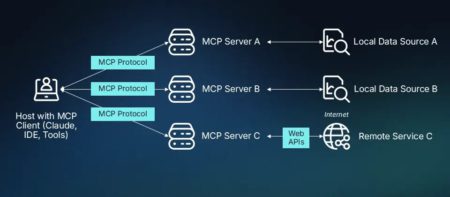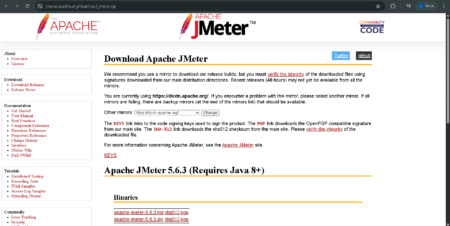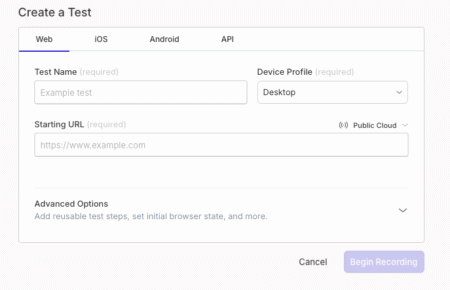Artificial Intelligence is no longer a distant dream; it’s rapidly reshaping how we build, test, and release software. And just when we thought GPT-4o was groundbreaking, OpenAI is gearing up to launch its next leap: GPT-5. For software testers, QA engineers, and automation experts, this isn’t merely another version upgrade; it’s a complete transformation. GPT-5
The post GPT-5 is Coming: Revolutionizing Software Testing appeared first on Codoid.
Software Engineering
AI is transforming accessibility testing by automating audits and reducing effort, but it can’t replace human judgment. This blog explores why a hybrid approach—AI-powered tools plus human-in-the-loop validation—is essential for reliable, inclusive digital experiences. Learn how Tx leverages this synergy to deliver accurate, scalable, and regulation-compliant accessibility testing solutions.
The post Win the Accessibility Game: Combining AI with Human Judgment first appeared on TestingXperts.
Artificial Intelligence is no longer a distant dream; it’s rapidly reshaping how we build, test, and release software. And just when we thought GPT-4o was groundbreaking, OpenAI is gearing up to launch its next leap: GPT-5. For software testers, QA engineers, and automation experts, this isn’t merely another version upgrade; it’s a complete transformation. GPT-5
The post GPT-5 is Coming: Revolutionizing Software Testing appeared first on Codoid.
The blog discusses how AI is leveling up the QA outsourcing industry by enhancing efficiency, improving code quality, and reducing costs. You will learn how to choose the right AI-driven QA partner and see how intelligent testing strategies can help you stay competitive in the digital age.
The post Lead with Intelligence: Rethink QA Outsourcing for the AI Age first appeared on TestingXperts.
Artificial Intelligence (AI) continues to revolutionize industries, driving unprecedented productivity and efficiency. One of its most transformative effects is on the field of automation testing, where AI tools are helping QA teams write test scripts, identify bugs, and optimize test coverage faster than ever. Among today’s standout AI tools are GitHub Copilot vs Microsoft Copilot.
The post GitHub Copilot vs Microsoft Copilot: What’s the Real Difference? appeared first on Codoid.
DevOps tooling has become mission-critical. What used to be a niche engineering function is now a core business driver. And…
In today’s high-velocity software development world, test automation has become the lifeblood of continuous integration and delivery. However, as testing needs grow more complex, automation tools must evolve to keep pace. One of the most promising innovations in this space is the Model Context Protocol (MCP), a powerful concept that decouples test logic from browser
The post Open Source MCP: Powering Scalable Test Automation appeared first on Codoid.
The blog discusses how scriptless automation streamlines test creation using visual, no-code tools ideal for fast, UI-focused testing. While accessible and quick to implement, it struggles with complex logic, backend testing, and large-scale maintainability. Careful evaluation is essential before adoption.
The post The Hidden Trade-Offs of Scriptless Automation Are You Sacrificing Strategy for Speed? first appeared on TestingXperts.
In the dynamic world of software development, the roles of Quality Assurance (QA) and Quality Engineering (QE) have become increasingly significant. Although often used interchangeably, QA and QE represent two distinct philosophies and approaches to ensuring software quality. Understanding the difference between QA vs QE isn’t just a matter of semantics; it’s a strategic necessity
The post QA vs QE: Understanding the Evolving Roles appeared first on Codoid.
If your QA team is stuck fixing broken scripts every sprint, you are burning time and money. This blog breaks down how AI-driven performance testing changes that situation. Learn how self-healing tests adapt to app changes, reduce failures, and shrink maintenance by half. See how you can keep pace with rapid releases, trust your automation results, and spend less on rework; all while letting your engineers focus on real performance improvements instead of endless patch jobs.
The post The art of cutting Test Maintenance in Half Welcome AI-Driven Performance Testing first appeared on TestingXperts.
Looking for the best smartphones under ₹30,000 in India? Whether you’re a gamer, a photography enthusiast, or someone who just wants a powerful phone with great battery and display, we’ve handpicked the top 8 phones available on Amazon that offer premium features at mid-range prices. Ranked based on customer reviews, features, and overall value, these phones deliver flagship-like performance without breaking the bank. Scroll down for the full list with images, prices, Amazon affiliate links, and a comparison chart to help you pick the perfect one!
1. Nothing Phone (3a Pro)
Affiliate link: https://amzn.to/46yaDTA
Price: ₹30,337 (approx)
Summary:
Launched March 2025 with Snapdragon 7s Gen 3, a 6.77″ LTPO AMOLED display, triple-camera (50 MP OIS + 50 MP telephoto + 8 MP ultrawide), 5,000 mAh battery with 50 W fast charge, and NothingOS with 3 years of Android + 6 years of security updates.
Highlights:
Unique transparent design + Glyph interface
Periscope zoom on Pro model
Smooth 120 Hz high-bright LTPO screen
2. Infinix GT 30 Pro
Affiliate link: https://amzn.to/3IgnP5yPrice: ₹24,999
Summary:
A gamer’s delight with Dimensity 8350 Ultimate, 144 Hz AMOLED display, RGB lighting, shoulder triggers, 5,500 mAh battery, 45 W charging, and a 108 MP main camera.
Highlights:
Excellent for gaming at 120 fps
Bright display with ultrafast refresh rate
Strong everyday performance
3. OnePlus Nord 4
Affiliate link: https://amzn.to/4eI6bUr
Price: ₹26,688 (after discounts)
Summary:
Now under ₹27 k with deals; but still solid with Snapdragon 7+ Gen 3, 6.74″ 120 Hz AMOLED, 5,500 mAh battery with 100 W fast charge, dual-camera (50 MP+8 MP), and OxygenOS experience.
Highlights:
Clean design with Snapdragon power
Ultra-fast wired charging
Premier display brightness
4. Realme GT 6
Affiliate link: https://amzn.to/3Gf5Dc1Price: ₹27,999
Summary:
Equipped with Snapdragon 8s Gen 3, 6.78″ AMOLED, 120 Hz, dual 50 MP + 50 MP rear cams, 5,500 mAh battery. Excellent display and camera stabilization
Highlights:
Powerful chipset under ₹30k
Bright, high-refresh display
Strong camera and fast charging
5. iQOO Neo 10R
Affiliate link: https://amzn.to/45UsRhSPrice: ₹26,999
Summary:
Launched March 2025 with Snapdragon 8s Gen 3, 6.78″ 144 Hz AMOLED, 6,400 mAh battery; 50 MP + 8 MP + 32 MP selfie cam. High performance and smooth visuals.
Highlights:
Ultra‑high 144 Hz refresh
Snapdragon flagship-like feel
Large battery and speedy performance
6. Realme 14 Pro + 5G
Affiliate link: https://amzn.to/4lhgst1
Price: ₹26,480
Summary:
Features Snapdragon 7s Gen 3, 6.83″ AMOLED 120 Hz, 50 MP Sony IMX896 OIS, 6,000 mAh battery. Flagship feel with premium camera and display.
Highlights:
Excellent imaging & stabilization
Stunning bright display
Clean software UI
7. Motorola Edge 60 Pro (Fusion?)
Affiliate link: https://amzn.to/40Ayj60Price: ₹27,999
Summary:
Featuring Dimensity 8350 Extreme, 6.7″ curved pOLED 120 Hz, clean Android 15 experience, reliable camera and battery life.
Highlights:
Curved OLED aesthetics
Smooth near-stock Android
Dependable camera and longevity
8. Oppo Reno 11 Pro 5G
Affiliate link: https://amzn.to/4kt1crV
Price: ₹29,999
Summary:
MediaTek Dimensity 8200, 6.74″ AMOLED, 50 MP + 32 MP + 8 MP cam, 32 MP selfie, 4,600 mAh battery.
Highlights:
Sleek lightweight design
Good for photography users
Premium feel in sub‑30k segment
📊 Final Rankings by Reviews & Value:
Nothing Phone (3a Pro) – Standout design, periscope zoom, top-tier support
Infinix GT 30 Pro – Gamer’s delight with 144 Hz + RGB + strong battery
OnePlus Nord 4 – Clean OxygenOS, blazing 100 W charge
Realme GT 6 – Flagship-like experience under ₹30k
iQOO Neo 10R – 144 Hz display, Snapdragon 8s performance
Realme 14 Pro + – Great camera & display, solid mid‑range
Motorola Edge 60 Pro – Curved OLED & near-stock UI
Oppo Reno 11 Pro 5G – Design-first with solid optics
🛍️ Tips Before You Buy
Gamer? Choose Infinix GT 30 Pro or iQOO Neo 10R.
Camera priorities? Realme 14 Pro+, Nothing 3a Pro, or Oppo Reno 11 Pro deliver.
Smooth, clean software? Go with OnePlus, Motorola, or Nothing.
Fastest charging? Nord 4 leads with 100 W; others offer 45–50 W.
Conclusion
All eight are excellent under ₹30 k. If style & long-term support matter most, go for Nothing Phone (3a Pro). If you play games heavily, the Infinix GT 30 Pro is tailor-made. For a balanced blend of performance and clean software, Nord 4, Realme, iQOO, or Moto Edge are/well‑rounded picks.
In the fast-paced world of software development, teams are expected to deliver high-quality products quickly, often under shifting requirements. Enter Test Driven Development in Agile, a software testing strategy that flips traditional coding on its head by writing tests before the actual code. This preemptive approach ensures that every new feature is verified from the
The post Test Driven Development in Agile Framework appeared first on Codoid.
Automation testing has revolutionized software quality assurance by streamlining repetitive tasks and accelerating development cycles. However, manually creating test scripts remains a tedious, error-prone, and time-consuming process. This is where Playwright Codegen comes in a built-in feature of Microsoft’s powerful Playwright automation testing framework that simplifies test creation by automatically generating scripts based on your
The post Playwright Codegen: Record Tests in Seconds appeared first on Codoid.
This blog explores how NLP-powered virtual assistants transform insurance customer support and improve underwriting. It explains core technologies like machine learning, speech recognition, and context awareness, driving these assistants. The blog also highlights crucial security and compliance guardrails needed for ethical deployment.
The post Why NLP Virtual Assistants Are No Longer Optional for Insurers first appeared on TestingXperts.
Delivering high-performance applications is not just a competitive advantage it’s a necessity. Whether you’re launching a web app, scaling an API, or ensuring microservices perform under load, performance testing is critical to delivering reliable user experiences and maintaining operational stability. To meet these demands, teams rely on powerful performance testing tools to simulate traffic, identify
The post JMeter vs Gatling vs k6: Comparing Top Performance Testing Tools appeared first on Codoid.
Selenium does not recognize webelements of Tableau. Is there any tool which is successful for UI automation of Tableau ?
Automated UI testing has long been a critical part of software development, helping ensure reliability and consistency across web applications. However, traditional automation tools like Selenium, Playwright, and Cypress often require extensive scripting knowledge, complex framework setups, and time-consuming maintenance. Enter Operator GPT, an intelligent AI agent that radically simplifies UI testing by allowing testers
The post Operator GPT: Simplifying Automated UI Testing with AI appeared first on Codoid.
Extended Reality (XR) transforms mobile app experiences through spatial interactions, real-time data, and immersive design. This blog explores key XR components, UX principles, testing strategies, and use cases across healthcare, retail, and gaming industries. It also addresses security, privacy, and ethical challenges unique to XR environments.
The post Your Customers See More Than Reality: Is Your Mobile Strategy Keeping Up? first appeared on TestingXperts.
The blog discusses how Enterprise Hyperautomation combines AI, RPA, and low-code platforms to automate complex processes, improve data accuracy, and accelerate digital transformation. By integrating these technologies, organizations streamline workflows, reduce manual effort, enhance compliance, and deliver agile, scalable solutions.
The post Why the Future Belongs to Enterprises That Build Intelligent Hyperautomation first appeared on TestingXperts.
Introduction to Cross-Browser TestingCross-browser testing is the process of verifying that web applications function consistently across different browser-OS combinations, devices, and screen sizes. With over 25,000 possible browser/device combinations in use today, comprehensive testing is essential for delivering quality user experiences.Why Cross-Browser Testing MattersBrowser Fragmentation: Chrome (65%), Safari (18%), Edge (6%), Firefox (4%) market share (2024 stats)Rendering Differences: Each browser uses different engines (Blink, WebKit, Gecko)Device Diversity: Mobile (58%) vs Desktop (42%) traffic splitBusiness Impact: 88% of users won’t return after a bad experienceCore Cross-Browser Testing Strategies1. Browser/Device Prioritization MatrixPriorityCriteriaExample TargetsTier 180%+ user coverage + business criticalChrome (Win/macOS), Safari (iOS), EdgeTier 215-80% coverage + key featuresFirefox, Samsung InternetTier 3Edge cases + progressive enhancementLegacy IE, Opera MiniPro Tip: Use Google Analytics to identify your actual user browser distribution.2. Responsive Testing MethodologyKey Breakpoints to Test:1920px (Large desktop)1366px (Most common laptop)1024px (Small laptop/tablet landscape)768px (Tablet portrait)375px (Mobile)3. Automation Framework Architecturejava// Sample TestNG XML for parallel cross-browser execution
<suite name=”CrossBrowserSuite” parallel=”tests” thread-count=”3″>
<test name=”ChromeTest”>
<parameter name=”browser” value=”chrome”/>
<classes>
<class name=”com.tests.LoginTest”/>
</classes>
</test>
<test name=”FirefoxTest”>
<parameter name=”browser” value=”firefox”/>
<classes>
<class name=”com.tests.LoginTest”/>
</classes>
</test>
</suite>Implementation Approaches1. Cloud-Based Testing SolutionsTool Comparison:ToolParallel TestsReal DevicesPricingBrowserStack50+Yes$29+/monthSauce Labs30+Yes$39+/monthLambdaTest25+Yes$15+/monthSelenium GridUnlimitedNoFreeExample Code (BrowserStack):javaDesiredCapabilities caps = new DesiredCapabilities();
caps.setCapability(“browser”, “Chrome”);
caps.setCapability(“browser_version”, “latest”);
caps.setCapability(“os”, “Windows”);
caps.setCapability(“os_version”, “10”);
WebDriver driver = new RemoteWebDriver(
new URL(“https://USERNAME:ACCESSKEY@hub-cloud.browserstack.com/wd/hub”), caps);2. Visual Regression TestingVisual regression testing is a quality assurance method that compares visual representations of web pages or application screens to detect unintended visual changes. Unlike functional testing, which verifies behaviors, visual testing focuses on:Layout integrityColor accuracyFont renderingElement positioningResponsive behaviorHow Visual Regression Testing Works?Recommended Tools:Applitools (AI-powered)Percy (Git integration)Selenium + OpenCV (Custom solution)Critical Checks:Font renderingBox model complianceCSS animation consistencyMedia query effectiveness3. Progressive Enhancement StrategyhtmlCopyDownloadRun<!– Feature detection example –>
<script>
if(‘geolocation’ in navigator) {
// Modern browser feature
} else {
// Fallback for legacy browsers
}
</script>Best Practices for Effective Testing1. Test Case Design PrinciplesCore Functionality FirstLogin flowsCheckout processesForm submissionsBrowser-Specific QuirkscssCopyDownload/* Firefox-specific fix */
@-moz-document url-prefix() {
.element { margin: 2px; }
}Performance BenchmarkingPage load timesFirst Contentful Paint (FCP)Time to Interactive (TTI)2. Debugging TechniquesCommon Issues & Solutions:ProblemDebugging MethodCSS inconsistenciesBrowser DevTools > Computed StylesJavaScript errorsSource Maps + Console logsLayout shiftsChrome Lighthouse > DiagnosticsPerformance gapsWebPageTest.org comparisonsConclusion and Next StepsImplementation Checklist:Audit current browser usage statisticsEstablish a testing priority matrixConfigure the automation frameworkSet up CI/CD integrationImplement visual regressionSchedule regular compatibility scansBonus ResourcesPerform Visual Testing using SeleniumBuild a Custom Visual Testing Tool








